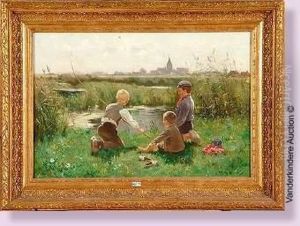Joseph, Jos Julien Paintings
Joseph Jos Julien, born in 1873 and deceased in 1934, was a Belgian artist whose work and influence spanned the late 19th and early 20th centuries. Though not as widely recognized as some of his contemporaries, Julien's contributions to the art world during his time were nonetheless significant, particularly in the context of Belgian art history. His career was marked by a dedication to exploring and expressing the nuances of daily life and the natural world through his art, employing a style that, while reflective of the movements of his time, also exhibited a distinct personal touch.
Educated in the arts during a period of rich artistic innovation, Julien was exposed to a variety of influences, including Impressionism and Symbolism, which were prevalent in Europe at the end of the 19th century. Despite these influences, he developed a unique approach to his work, focusing on rural landscapes, city scenes, and portraits with a sensitivity to light, color, and form that was all his own. His landscapes, often depicting the Belgian countryside, are particularly noted for their serene beauty and meticulous detail, reflecting a deep appreciation for his natural surroundings.
Throughout his career, Julien participated in numerous exhibitions, gaining recognition and accolades for his work. He was associated with various artistic circles and groups in Belgium, contributing to the vibrant cultural life of the country during his lifetime. However, much like many artists of his era, Julien's name became somewhat obscure in the years following his death, overshadowed by the more prominent figures of his generation.
In recent years, there has been a renewed interest in Joseph Jos Julien's work, leading to a reevaluation of his place within the context of Belgian and European art history. Art historians and critics now recognize him as an important figure who contributed to the richness and diversity of Belgian art in the late 19th and early 20th centuries. His paintings, cherished for their emotional depth and technical skill, continue to be sought after by collectors and admired in galleries and museums dedicated to preserving the legacy of Belgium's artistic heritage.
